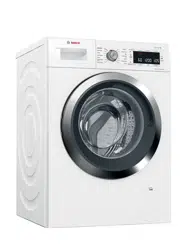Documents: Go to download!
- Owner's manual - (English)
- Positioning and connecting
- Main points in brief
- Overview of programmes
- Operating the appliance
- Cleaning and maintenance
- Faults and what to do about them
Table of contents
User Guide
Positioning and connecting
Included with the appliance
Note: Check the machine for transport damage. Never use a damaged machine. If you have any complaints, contact the dealer from whom you purchased the appliance or our customer services. ~ Page 56

1. Mains cable
2. Bag
- Installation and operating instructions
- Customer services location directory*
- Warranty*
- Cover caps for openings after the transport braces have been removed
- Adaptor with sealing washer from 21 mm = ½" to 26.4 mm = ¾" *
3. Water supply hose on Aqua-Stop models
4. Water drain hose
5. Elbow for securing the water drain hose*
6. Water supply hose on standard/ Aqua-Secure models * depending on the model
Caution!
- Damage to the appliance
- The machine is secured for transportation using transport locks.
- If the transport locks are not removed, the drum, for example, may become damaged when the machine is operated.
- Before using the appliance for the first time, make sure that you completely remove all four transport locks. Keep the locks in a safe place.
- To prevent transport damage from occurring if the appliance is moved at a later date, you must refit the transport locks before transporting the appliance.
Removing the transport locks
Damage to the appliance
- The machine is secured for transportation using transport locks.If the transport locks are not removed, the drum, for example, may become damaged when the machine is operated.Before using the appliance for the first time, make sure that you completely remove all four transport locks. Keep the locks in a safe place.
- To prevent transport damage from occurring if the appliance is moved at a later date, you must refit the transport locks before transporting the appliance.
Note: Keep the screws and sleeves in a safe place.
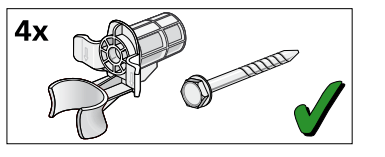
1. Take the hoses out of the holders
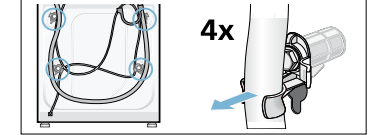
2. Unscrew and remove all four transportation securing bolts with a wrench (WAF 13). Remove the sleeves. Remove the mains cable from the holders.
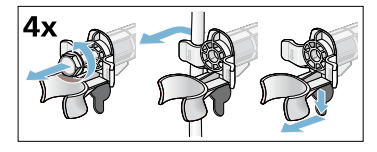
3. Insert the covers. Lock the covers firmly in place by applying pressure to the snap-in hooks.
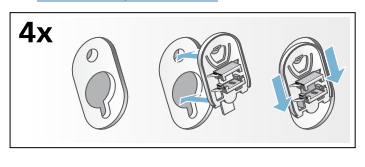
Hose and cable lengths
Left-hand connection
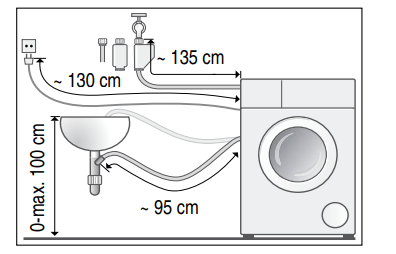
Right-hand connection

Tip:
The following are available from specialist dealers/customer services:
- Extension for Aqua-Stop and cold water supply hose (approx. 2.50 m); order no. WM Z2380, WZ 10130,
- A longer supply hose approx. 2.20 m) for standard models; individual component number for customer services
Water inlet
There is a risk of electric shock if you touch live components. Do not immerse the Aqua-Stop safety valve in water (it contains an electric valve).
Notes
- Only operate the washing machine using cold mains water.
- Do not connect the machine to the mixer tap of an unpressurised hotwater boiler.
- Do not use a used supply hose. Only use the supply hose supplied or one that was purchased from an authorised specialist retailer.
- Do not kink or squash the water supply hose.
- Do not alter (shorten, cut through) the water supply hose (otherwise its strength is no longer guaranteed).
- Only tighten the screw connections by hand. If the screw connections are tightened too much with a tool pliers), the thread may become damaged.
- When connecting to a 21 mm = ½" tap, first fit an adapter* with a sealing washer from 21 mm = ½" to mm = ¾". supplied depending on the model

Connection
Connect the water supply hose to the tap (26.4 mm = ¾") and to the appliance (not necessary for Aqua-Stop models as this is permanently installed):
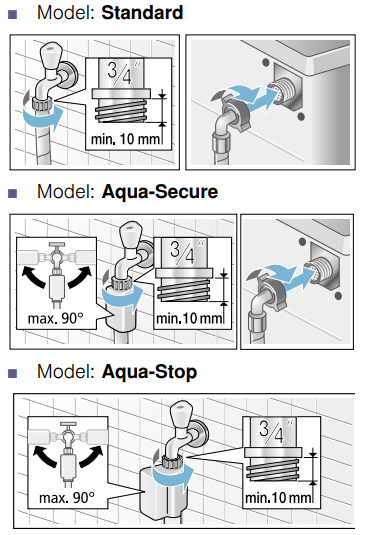
Note: Turn on the tap carefully, checking the leak tightness of the connection points. The screw connection is under mains water pressure.
Water outlet
- When you are washing at high temperatures, there is a risk of scalding if you come into contact with hot water e.g. when draining hot water into a washbasin).
- Do not reach into the hot water.
Water damage
- If the drain hose slips out of the washbasin or the connection point during draining due to high water pressure, any escaping water may cause water damage.
- Secure the drain hose so that it cannot slip out.
Damage to the appliance/fabrics
If the end of the drain hose is immersed in the drained water, water may be sucked back into the appliance and may damage the appliance/fabrics. Make sure that:
- The plug does not block drainage from the washbasin.
- The end of the drain hose is not immersed in the drained water.
- The water drains away quickly enough.
Note: Do not kink the water drain hose or put strain on it lengthways.
Connection
Drainage into a washbasin
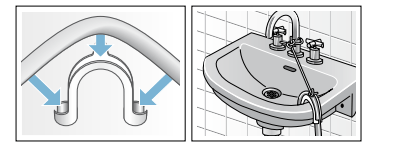
Drainage into a siphon
The connection point must be secured using a hose clamp with a diameter of 24 - 40 mm (available from specialist dealers).
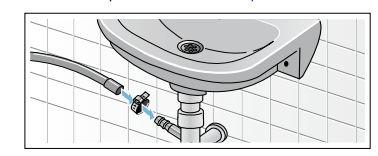
Drainage into a plastic pipe with rubber bushing or into a drainage pit
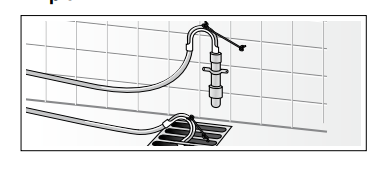
Levelling
Align the appliance using a spirit level.
Incorrect alignment may result in loud noises, vibrations and machine movement".
- Loosen the lock nuts using a WAF17 spanner, by turning it in a clockwise direction.
- Check the alignment of the washing machine with a spirit level, and adjust it if necessary. Change the height by turning the appliance feet. All four appliance feet must stand firmly on the ground.
- The lock nuts on all four appliance feet must be screwed tightly against the housing using a suitable WAF17 spanner. In doing so, hold the foot tight and do not adjust its height.
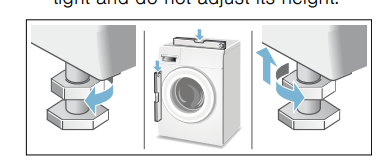
Electrical connection
Danger of death!
There is a risk of electric shock if you touch live components.
- Never touch or hold the mains plug with wet hands.
- Only pull out the mains cable by the plug and never by the cable, as this could damage it.
- Never unplug the mains plug during operation.
Observe the following information and ensure that:
■ The mains voltage and voltage indicated on the washing machine (rating plate) are the same. The connected load and fuse required are specified on the rating plate.
■ The washing machine is only connected to an alternating current supply via a properly installed earthed socket.
■ The mains plug fits the socket.
■ The cable cross-section is adequate.
■ The earthing system is properly installed.
■ The mains cable is only replaced by a qualified electrician (if this is necessary). Replacement mains cables are available from customer services.
■ No multiple plugs/couplings or extension cables are used.
■ If an earth-leakage circuit breaker is used, only a type which displays the z symbol is used. Only this symbol guarantees compliance with the currently applicable regulations.
■ The mains plug can be accessed at all times. If this is not possible, in order to comply with the relevant safety regulations, a switch (2-pole switch-off) must be built into the permanent installation in accordance with electrical installation regulations.
■ The mains cable is not kinked, squashed, altered or cut through.
■ The mains cable does not come into contact with heat sources.
Before washing for the first time
- The washing machine was thoroughly tested before leaving the factory. To remove any water that may be left over from the test, run the first wash cycle without any laundry.
Notes
- The washing machine must be correctly installed and connected. from ~ Page 14)
- Never use a damaged machine. Inform the after-sales service.
Preparatory work:
- 1. Check the machine.
- 2. Fill the
 dispenser and ~
dispenser and ~  Page 43
Page 43 - 3. Remove the protective film from the control panel.
- 4. Plug into the mains.
- 5. Turn on the tap.
Run the programme without laundry:
- 1. Switch on the appliance.
- 2. Close the door (do not load any laundry).
- 3. Set the Drum Clean 90 °C programme.
- 4. Open the detergent drawer.
- 5. Pour approx. 1 litre of water into compartment

- 6. Pour standard washing powder into compartment

- Note: To prevent foaming, only use half of the amount of detergent recommended by the detergent manufacturer. Do not use detergents that are intended for wool or delicates.
- 7. Close the detergent drawer.
- 8. Press the
 button.
button. - 9. Switch off the appliance at the end of the programme.
Fitting the transportation securing means:
1. Remove the covers and keep them in a safe place. If required, use a screwdriver.
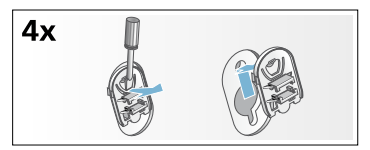
2. Insert all four sleeves. Clip the mains cable securely in the holders. Insert the transportation securing bolts and tighten them with a wrench (WAF 13).
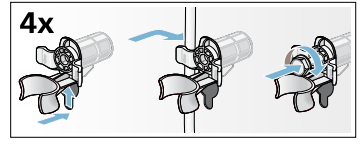
Before switching on the appliance again:
- Always remove the transport braces.
- To prevent unused detergent from flowing straight into the drain during the next wash: Pour approx. 1 litre of water into compartment
 and start the Drain programme.
and start the Drain programme.
Main points in brief
Connect the mains plug.
Turn on the tap. Open the door.
To switch on, press the  button.
button.
Select a programme, e.g.

Sort the laundry.
Observe the maximum load (depending on the model) on the display panel.
Load the laundry.
Close the door.

If necessary, change the default programme settings and/or select additional settings. Start the programme

If necessary, change the default programme settings and/or select additional settings.
Start the programme.

End of the programme
Open the door and remove the laundry.
To switch off, press the button.
button.
Turn off the tap (for models without Aqua-Stop).
Washing machine

Laundry
- Prepare the laundry
- Caution!
- Damage to the appliance/fabrics
- Foreign objects (e.g. coins, paperclips, needles, nails) may damage the laundry or components in the washing machine.
- You should therefore note the following tips when preparing your laundry:
Control panel

All the buttons are sensitive (except for the main switch) and only need to be pressed lightly
- Main switch
- for switching the washing machine on and off:
- Press the
 button
button
- Press the
- for switching the washing machine on and off:
- Programme selector
- for selecting a programme:
- Overview of programmes ~ Page 30
3. 8 i-DOS
- settings ~ Page 43
4. Additional programme settings:
- SpeedPerfect,
- EcoPerfect,
- Prewash,
- Rinse Plus,
- Easy Iron
5. Changing the default programme settings:
- Temperature,
- Spin speed (Spin),
- Finished in time
6. Child lock 3 sec 
- To prevent the set functions from being changed accidentally: Press and hold the Finished in + and - button at the same time for approx. 3 seconds to activate this function. ~ Page 41
7.  button for:
button for:
- Starting a programme
- Interrupting a programme, e.g. to add items of laundry ~ Page 41
- Cancelling a programme
8 Display panel
- For settings and information.
Display panel

1. i-DOS settings
 Detergent:
Detergent:
 for lightly soiled laundry
for lightly soiled laundry for medium soiled laundry,
for medium soiled laundry, for heavily soiled laundry
for heavily soiled laundry
 Fabric softener:
Fabric softener:
 for soft laundry,
for soft laundry, for medium soft laundry,
for medium soft laundry, for very soft laundry
for very soft laundry
 automatic dosage deselected,
automatic dosage deselected,


 flash; the fill level of the respective container has dropped below the minimum level, filling
flash; the fill level of the respective container has dropped below the minimum level, filling
2.Temperature in °C  -90 (
-90 ( = cold)
= cold)
3. Spin speed in rpm,  0 - 1600*;
0 - 1600*;
* Max. spin speed, depending on the selected programme and model
- 0 = no spin cycle, draining only
 = Rinse Stop ~ Page 36
= Rinse Stop ~ Page 36
4.
- Finished in time
- Programme duration depends on the programme selection in h:min (hours:minutes),
- Preselection of end time
- 1 - 24 h; Programme ends after ... h (h = hours),
- Base dosing quantity
- ml 10-200 ~ Page 45
- Load recommendation
- depending on the selected programme
5. Information on energy and water consumption: ~ Page 13
 Water consumption display,
Water consumption display, Energy consumption display
Energy consumption display
Prepare the laundry
Foreign objects (e.g. coins, paperclips, needles, nails) may damage the laundry or components in the washing machine.
You should therefore note the following tips when preparing your laundry:
- Empty any pockets.
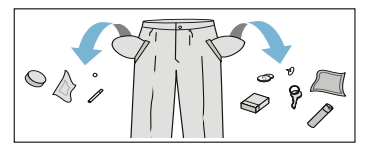
- Look out for metal items (paperclips, etc.) and remove them.
- Wash delicates in a laundry bag tights, underwired bras, etc.).
- Close any zips; button up any cover buttons.
- Brush sand out of pockets and collars.
- Remove curtain fittings or place curtains in a laundry bag.
Sorting laundry
Sort your laundry according to the care instructions and manufacturer's information on the care labels, depending on:
- Type of fabric/fibre
- Colour
- Note: Laundry may discolour. Wash white and coloured items separately. Wash new coloured items separately the first time you wash them.
- Soiling
- Wash laundry with the same level of soiling together.
- Some examples of soiling levels can be found on ~ Page 29
- Light: Do not prewash, select the SpeedPerfect setting if
- Normal
- Heavy: Load less laundry, select a programme with prewash –
- Stains: Remove/pretreat stains while they are fresh. Firstly, dab with soapy water; do not rub. Then wash the items of laundry with the appropriate programme. Stubborn or dried-in stains can sometimes only be removed by washing several times.
- Symbols on the care labels
Note: The numbers in the symbols indicate the maximum washing temperature that may be used.
 Suitable for normal washing process; e.g. Cottons programme
Suitable for normal washing process; e.g. Cottons programme
 A gentle washing process is required; e.g. Easy-Care programme
A gentle washing process is required; e.g. Easy-Care programme
 An especially gentle washing process is required; e.g. Delicate/Silk programme
An especially gentle washing process is required; e.g. Delicate/Silk programme
 Suitable for washing by hand; e.g.
Suitable for washing by hand; e.g.
 Woollens programme . Do not machine wash.
Woollens programme . Do not machine wash.
Correct selection of detergent
The care label is crucial for selecting the correct detergent, temperature and treatment of the laundry.
- Standard detergent with optical brighteners
- Suitable for boil-washable white laundry made from linen or cottonProgramme: Cottons/ cold - max. 90 °C
- Detergent for colours without bleach or optical brighteners
- Suitable for coloured laundry made from linen or cotton Programme: Cottons/ cold - max. 60 °C
- Detergent for colours/delicates without optical brighteners
- Suitable for coloured laundry made from easy-care fibres, synthetic fibres Programme: Easy-Care/ cold - max. 60 °C
- Detergent for delicates
- Suitable for delicate, fine fabrics, silk or viscose Programme: Delicate/Silk/ cold - max. 40 °C
- Detergent for woollens
- Suitable for wool
- Wool programme/ cold - max. 40 °C
Saving energy and detergent
For light and normal soiling, you can save energy (lower washing temperature) and detergent.
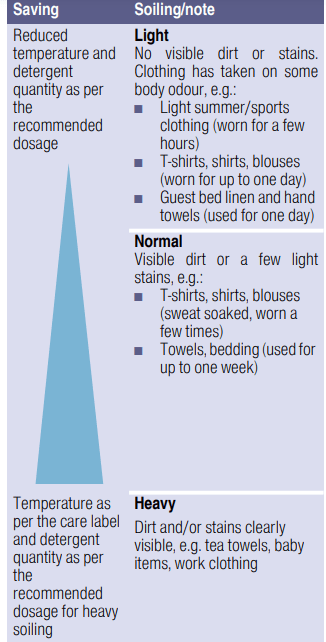
Note: When measuring the amount of all detergents/additives/care products and cleaning agents, please always check the manufacturer's instructions and information.
Overview of programmes
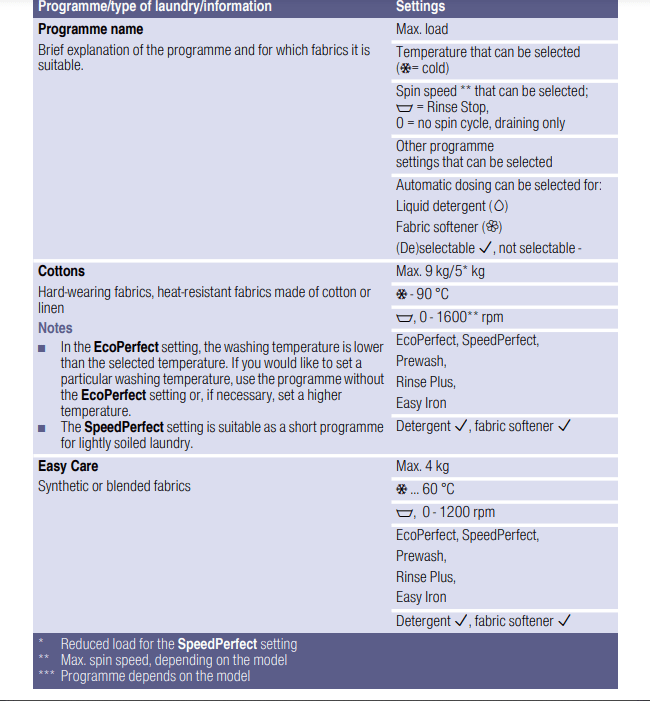

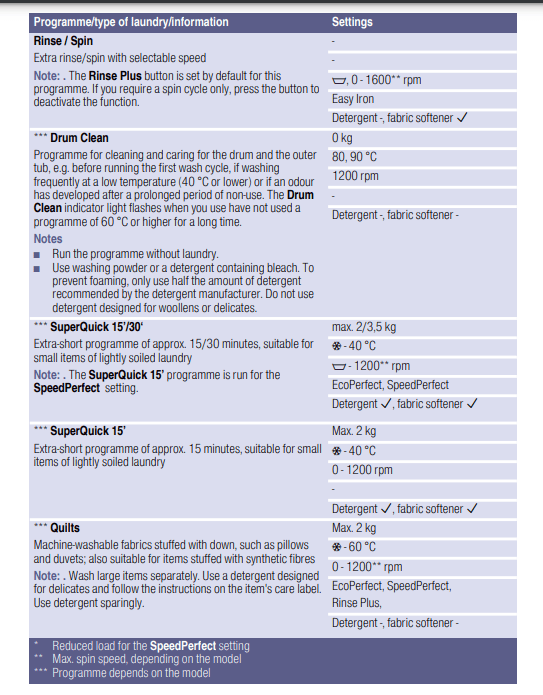


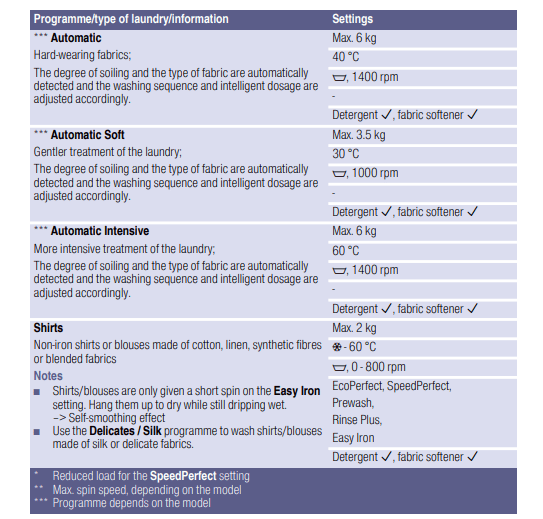
Starching
Note: Laundry should not be treated with fabric softener.
1. Switch on the appliance.
2. Select the Rinse programme.
3. Pour liquid starch into compartment  in accordance with the manufacturer's instructions (clean first if necessary).
in accordance with the manufacturer's instructions (clean first if necessary).
4. Press the  button.
button.
Dyeing/bleaching
- Dye should only be used in normal household quantities. Salt may damage stainless steel. Always follow the dye manufacturer's instructions.
- Do not use the washing machine to bleach clothes
Soaking
1. Switch on the appliance.
2. Select the Cottons 30 °C programme.
3. Use i-DOS to dose your detergent or add it to compartment  in accordance with the manufacturer’s instructions.
in accordance with the manufacturer’s instructions.
4. Press the  button. The programme starts.
button. The programme starts.
5. After approx. 10 minutes, press the  button to pause the programme.
button to pause the programme.
6. Leave the laundry to soak for as long as required, then either press the  button again to continue the programme or change the programme.
button again to continue the programme or change the programme.
Notes
- Load laundry of the same colour.
- No additional detergent is required; the soaking solution is used for washing.
Programme default settings
- Program deef aul t settingsThe default programme settings are displayed in the display panel after selecting the programme.
- You can change the default settings.
- An overview of all programme settings, which can be selected depending on the programme, can be found from ~ Page 30.
Switching on the appliance/ selecting a programme
- Press the
 button. The appliance is switched on.
button. The appliance is switched on. - The Cottons programme set at the factory is then always displayed.
- You can use this programme or select a different programme. The programme selector can be turned in either direction.
Note: If you have activated the childproof lock, you must deactivate it before you can set a programme.
You can change the default settings.
- An overview of all programme settings, which can be selected depending on the programme, can be found from
Temperature
- Depending on what stage the programme is in, you can change the set temperature before and during the programme.
- The maximum temperature that can be set depends on the programme that has been selected.
Spin speed
- Depending on what stage the programme is in, you can change the spin speed (in rpm; revolutions per minute) before and during the programme.
- Setting 0: The rinsing water is drained but there is no final spin. The laundry stays wet inside the drum, e.g. for items that should not be spun.
- Setting
 : Rinse Stop = no final spin. The laundry stays in the water after the final rinse.
: Rinse Stop = no final spin. The laundry stays in the water after the final rinse.
- You can select “Rinse Stop” to prevent creasing if the laundry will not be taken out of the washing machine immediately after the programme has ended.
- To continue/end the programme ~ Page 42
Finished in
Before starting the programme, you can preselect the programme end ("Ready in" time) in hourly increments (h = hour) up to a maximum of 24 hours.
To do this:
1. Select a programme. The programme duration is displayed for the selected programme, e.g. 2:30 (hours:minutes).
2. Press the Finished in button repeatedly until the required number of hours is displayed.
Note: The setting values are increased using the Finished in + button, and decreased using the Finished in - button.
3. Press the  button. The programme starts. The selected number of hours (e.g. 8 h) is shown in the display panel and counts down until the wash programme starts. The duration of the programme is then displayed.
button. The programme starts. The selected number of hours (e.g. 8 h) is shown in the display panel and counts down until the wash programme starts. The duration of the programme is then displayed.
Note: The length of the programme is automatically adjusted when the programme is running. Changes to the default programme settings or programme settings may also change the programme duration
After starting the programme (if a Finished in time has been selected and the wash programme has not yet started), you can change the preselected number of hours as follows:
1. Press the  button.
button.
2. Use the Finished in - or + button to change the number of hours.
3. Press the  button. After starting the programme, you can add or remove laundry if necessary. ~ Page 41
button. After starting the programme, you can add or remove laundry if necessary. ~ Page 41
Rinse Plus
- Additional rinse cycle for particularly sensitive skin and/or for areas with very soft water.
Easy Iron
- Reduces creasing thanks to a special spin sequence followed by fluffing and reduced spin speed.
Note: The washing's residual moisture is increased.
Operating the appliance
Preparing the washing machine
Note: The washing machine must be correctly installed and connected. From ~ Page 14.
- Connect the mains plug.
- Turn on the tap.
- Open the door.
- Check that the drum is completely drained. Drain if necessary.
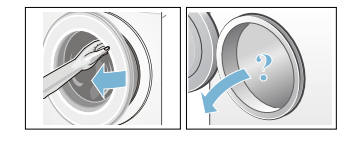
Switching on the appliance/ selecting a programme
Press the  button. The appliance is switched on.
button. The appliance is switched on.
The Cottons programme set at the factory is then always displayed.
You can use this programme or select a different programme. The programme selector can be turned in either direction.
Note: If you have activated the childproof lock, you must deactivate it before you can set a programme. ~ Page 41
The indicator light on the programme selector lights up and the default programme settings for the selected programme appear in the display panel.
■ Temperature
■ Spin speed
■ The maximum load and the duration of the programme (alternately)
■ The indicator light for the i-DOS settings, if intelligent dosage has been selected
■ Information on water and energy consumption
In appliances with a drum light:
The drum is lit after switching on the appliance, after opening and closing the door and after starting the programme. The light switches off automatically
Change the programme default settings
- You can use the default settings for each washing cycle or change them.
- To do this, repeatedly press the corresponding button until the required setting is displayed.
Note:
- Pressing and holding the buttons automatically runs through the setting values until the last one. Then press the button again and you will be able to change the setting values again.
The settings are activated without needing to be confirmed.
Notes
- The i-DOS settings are saved until they are changed again, even if the washing machine is switched off.
- Other programme settings are not saved if the washing machine is switched off.
Placing laundry into the drum
- Items of laundry pretreated with cleaning agents that contain solvents, e.g. stain remover/cleaning solvent, may cause an explosion after being loaded into the washing machine. Hand-rinse these items of laundry thoroughly beforehand.
Notes
- Mix items of laundry of varying sizes.Laundry items of different sizes distribute themselves better during the spin cycle. Individual laundry items may cause an unbalanced load.
- Observe the maximum specified load. Overfilling adversely affects the washing result and promotes creasing.
- Unfold presorted laundry items and place them in the drum.
- Make sure that no items of laundry are trapped between the door and the rubber seal, and close the door
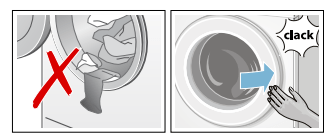
The  button indicator lamp flashes and the programme settings appear in the display panel.
button indicator lamp flashes and the programme settings appear in the display panel.
Select additional programme settings
- By selecting additional settings, you can better adapt the washing process to your items of laundry.
- The settings can be selected or deselected depending on the programme progress.
- The button indicator lamps light up if a setting is activated.
- The settings are not saved after switching off the washing machine.
- Additional programme settings
Select additional programme settings
- By selecting additional settings, you can better adapt the washing process to your items of laundry.
- The settings can be selected or deselected depending on the programme progress.
- The button indicator lamps light up if a setting is activated.
- The settings are not saved after switching off the washing machine
- Additional programme settings
Start the programme
- Press the
 button.
button. - The indicator lamp lights up and the programme starts. The display panel shows the "Ready in" time while the programme is running or the programme length and the programme progress symbols when the washing programme has started. Display panel ~ Page 26
Note: Foam detection
- If the
 symbol also lights up in the display panel, the washing machine has detected too much foam during the wash programme and automatically activated additional rinse cycles to remove the foam. Add less detergent to the next washing cycle with the same load.
symbol also lights up in the display panel, the washing machine has detected too much foam during the wash programme and automatically activated additional rinse cycles to remove the foam. Add less detergent to the next washing cycle with the same load. - If you want to lock the programme to prevent it from being inadvertently adjusted, you can select the childproof lock as follows.
Notes
■ Do not leave the door open for too long when adding laundry as water from the laundry may leak out.
■ For safety reasons, the door remains locked when the water level or temperature is high, or while the drum is turning, and it is not possible to add laundry during this time.
■ The load display is not active during reloading.
Changing the programme
If you have started the wrong programme by mistake, you can change the programme as follows:
1. Press the  button.
button.
2. Select another programme.
3. Press the  button. The new programme starts from the beginning.
button. The new programme starts from the beginning.
Cancel the programme
For programmes at high temperatures:
1. Press the  button.
button.
2. To cool down laundry: Select Rinse.
3. Press the  button.
button.
For programmes at low temperatures:
- 1. Press the
 button.
button. - 2. Select Spin or Drain.
- 3. Press the
 button.
button.
Programme end during rinse hold
In the display panel,  flashes, and the preset spin speed and remaining programme length are displayed for the selected programme.
flashes, and the preset spin speed and remaining programme length are displayed for the selected programme.
Continue the programme by:
■ Pressing the  button or
button or
■ Changing the spin speed, or setting the programme selector to Drain and then pressing the button.
button.
Child lock 3 sec.
- You can lock the washing machine to prevent the functions you have set from being changed inadvertently. To do this, activate the childproof lock.
- To activate/deactivate, press and hold the Finished in - and + buttons at the same time for approx. three seconds.
- The E symbol is appears in the display panel.
- E lights up: The childproof lock is active.
- E flashes briefly: The childproof lock is active and the programme selector was turned or a button was pressed.
Note:
- The childproof lock remains active, even once the washing machine has been switched off. Before selecting the next programme, deactivate the childproof lock.
Adding laundry
- After starting the programme, you can add or remove laundry if necessary.
- Press the
 button to do this.
button to do this. - The
 button indicator lamp flashes and the machine checks whether it is possible to add laundry.
button indicator lamp flashes and the machine checks whether it is possible to add laundry. - If the following appears in the display panel:
- Both the
 and symbols light up, it is possible to add laundry.
and symbols light up, it is possible to add laundry. - P - lights up, it is not possible to add laundry.
Continue the programme by:
- Pressing the
 button or
button or - Changing the spin speed, or setting the programme selector to Drain and then pressing the
 button.
button.
Intelligent dosing system emIntelligent dosing system in the detergent drawer
- The detergent drawer i-DOS Intelligent Dosing system Your washing machine has an intelligent dosing system for liquid detergent and fabric softener.
- The i-DOS compartments and i in the detergent drawer are used for this purpose.
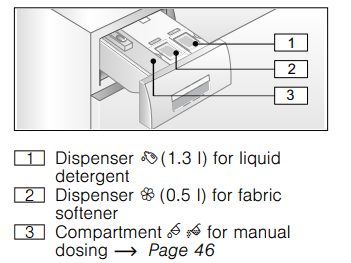
Initial use/filling the dispensers
- Refer to the manufacturer's instructions when choosing your detergent and fabric softener. We recommend the use of standard, universal and colour liquid detergents for all machine-washable, coloured fabrics made of cotton or synthetic materials.
Notes
- Only use easy-pour liquid products that the manufacturer recommends adding to the detergent drawer.
- Do not mix different liquid detergents. If changing your liquid detergent (type, manufacturer, etc.), empty the dispenser completely and clean it. ~ Page 49
- Do not use products containing solvents, caustic agents or volatile substances (e.g. bleach).
- Do not mix detergent and fabric softener.
- Do not use products that have expired or are highly congealed.
- To prevent drying out, do not leave the dispenser lids open for a long period of time.
Filling the dispensers:
The lids of the dispensers in the detergent drawer are marked with the following symbols:
 Standard/universal detergent i Fabric softener
Standard/universal detergent i Fabric softener Open the detergent drawer.
Open the detergent drawer.
- Open the dispenser lid(s).
- Open the dispenser lid(s)
- Add detergent and/or fabric softener. Do not fill above the max. marking.
- Close the lid(s).
- Slowly push the detergent drawer in completely
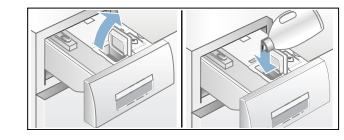
When the appliance is switched on, the fact that the detergent drawer is closed completely is indicated by the following:
- If intelligent dosage i-DOS
 or i-DOS
or i-DOS has been selected, the corresponding indicator lights up.
has been selected, the corresponding indicator lights up. - If intelligent dosage has not been selected, the indicator flashes once and then goes out.
- The

 symbol in the display panel goes out.
symbol in the display panel goes out.
Topping up the detergent/ fabric softener:
- If the indicator light for the selected intelligent dosage flashes, this means that the amount of detergent or fabric softener in the dispenser is below the minimum fill level. The contents will last for another three washes or so.
- The same detergent or fabric softener can be added at any time. If you change product/manufacturer, we recommend that you clean the dispensers first.
- If required, adjust the basic dosage.
Basic settings
The basic dosages are:
- For detergents – based on the manufacturer’s recommendation for average soiling and the respective water hardness.
- F or fabric softeners – based on the manufacturer's recommendation for a medium level of softness.
Refer to the packaging label on your detergent/fabric softener or ask the manufacturer directly for this information.
To find out the hardness of your water supply, use a test strip or check with your water supplier.
Below is an example of detergent dosages on a packaging label:

The default setting for the basic dosage is set specifically according to the area in which you live (e.g. 75 ml for detergent and 36 ml for fabric softener).
Set the basic detergent dosage according to the detergent's packaging label. Take your water hardness into consideration when doing so.
Select the basic fabric softener dosage according to how soft you would like your laundry to be.
Changing one basic dosage affects all three dosage quantities in the same way.
Notes
- Reduce the basic dosage if using a very concentrated detergent.
- If large amounts of foam are repeatedly created during washing, please check your basic dosage and dosage quantity settings. Certain types of liquid detergent can also create excessive amounts of foam. If your basic dosage and dosage quantity settings are correct, we advise you to use a different detergent.
Appliance settings
You can change the following settings:
- The volume of the buttons and the information signals (e.g. at the end of the programme)
- Select/deselect the appliance's automatic switch-off function
- Switch the drum-care information signal on/off (depending on the model).
You will need to activate the setting mode in order to change these settings
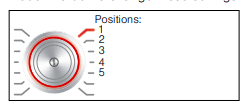
Automatic load sensing
- Depending on the type of fabric and load, the automatic load sensing function optimally adjusts the water consumption and programme duration in each programme.
Unbalanced load detection system
- The automatic unbalanced load detection system detects imbalances and ensures even distribution of the laundry by repeatedly starting and stopping drum spinning.
- If the laundry is extremely unevenly distributed, the speed is reduced or the spin cycle is not performed for safety reasons.
Note: Place large and small items of laundry evenly in the drum. ~ Page 40, ~ Page 54
AquaSensor
- Depending on the program and model During a rinse cycle, the Aqua sensor checks the turbidity of the rinsing water (turbidity is caused by dirt and detergent residue). The duration and the number of rinse cycles depend on the turbidity of the water
Machine housing/control panel
■ Wipe the housing and the control panel with a soft, damp cloth
■ Remove the detergent residue immediately.
■ Do not clean with a water jet.
Drum
- Use chlorine-free cleaning agents, do not use steel wool. If there are odours in the washing machine, or to clean the drum, run the Drum Clean 90 °C programme without laundry. Add washing powder.
Descaling
- Descaling should not be necessary if the detergent is measured out correctly. However, if it is required, follow the manufacturer's instructions for the descaling agent. Suitable descalers can be obtained via our website or from customer services. ~ Page 56
Cleaning and maintenance
Emptying the dispensers:
The dispensers have emptying outlets with removable sealing plugs at the front. To empty the dispensers, first remove the drawer handle as shown below:
a) Pull out the detergent drawer.
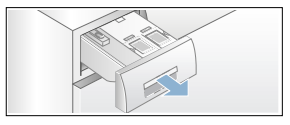
b) Pull the catch (A) on the back of the drawer handle (in the centre at the bottom) slightly towards you. This unlocks the drawer handle (B), which you can then pull off by lifting it upwards.
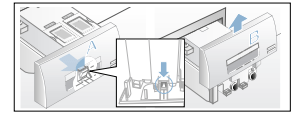
c) To empty the dispensers, carefully pull off each of the sealing plugs and empty the contents into a suitable container.
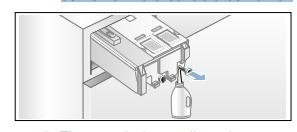
d) Then push the sealing plugs back in completely
Cleaning the dispensers/detergent drawer:
The detergent drawer can be removed completely to allow you to clean to dispensers after you have emptied them.
a) Empty the dispensers before removing the drawer
Note: Only put the drawer handle back on after you have finished cleaning. b) Pull out the drawer. c) Press the catch and remove the drawer completely.
b) Pull out the drawer.
c) Press the catch and remove the drawer completely.
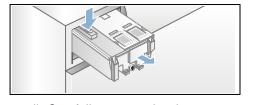
d) Carefully remove the drawer cover.

Caution!
Risk of damage to the detergent drawer. The detergent drawer contains electrical components. These may become damaged if they come into contact with water.
– Do not clean the cover in the dishwasher and do not immerse it in water.
– Protect the rear drawer connector against water, detergent or fabricsoftener residue; if necessary, clean the outer surfaces with a soft, damp cloth. Dry before putting back in
e) Clean the drawer and the cover with a soft, damp cloth or a hand shower. Also clean the inner surfaces with a soft, damp cloth.
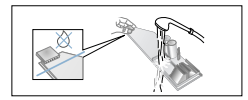
f) Dry the drawer and the cover and put them back together.
g) Push the drawer handle back in from above until you feel it click in place.
h) Clean the inside of the detergentdrawer housing.
i) Push the detergent drawer in completely.
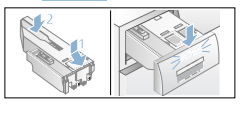
The drain pump is blocked, emergency draining
When you wash at high temperatures, the water gets very hot. If you come into contact with the hot water, you may be scalded.
Allow the water to cool down.
1. Turn off the water tap so that no more water can flow in and has to be drained via the drain pump.
2. Switch off the appliance. Pull out the mains plug.
3. Open and remove the service flap
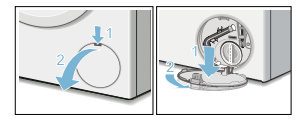
4. Take the drain hose out of the retainer. Remove the sealing cap and pour the water out into a suitable container. Replace the sealing cap and place the drain hose back in the retainer.
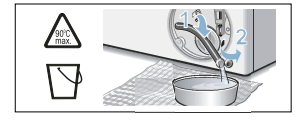
5. Carefully unscrew the pump cover; residual water may leak out. Clean the interior, pump-cover thread and pump housing. The impeller in the drain pump must be able to rotate. Refit the pump cover and screw it on tightly. The handle must be in a vertical position

6. Put the service flap back on, lock it into place and close it.
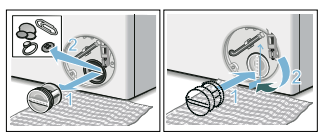
Put the service flap back on, lock it into place and close it.
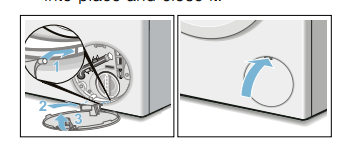
Note: To prevent unused detergent from flowing straight into the drain during the next wash, pour 1 litre of water into compartment  and start the Drain programme.
and start the Drain programme.
The drain hose at the siphon is blocked
- Switch off the appliance. Pull out the mains plug.
- Loosen the hose clamp. Carefully remove the drain hose; residual water may leak out.
- Clean the drain hose and siphon connecting piece

- Re-attach the drain hose and secure the connection point using the hose clamp
Faults and what to do about them
Water is leaking out.
- Attach the drain hose correctly or replace it.
- Tighten the screw connection of the drain hose.
The machine is not filling with water.
Detergent is not being dispensed.
- Have you pressed the
 button?
button? - Is the tap turned on?
- Could the filter be clogged? Clean the filter.~ Page 52
- Is the supply hose kinked or trapped?
The dispenser is empty and fill level indicator is not flashing.
- Is the drawer cover/connector dirty? Clean the detergent drawer.
- Has the detergent drawer been pushed in correctly? ~ Page 43
The wrong detergent/ fabric softener has been poured into the dispenser(s).
- Dispenser(s):
- Empty and clean. ~ Page 49
- Refill. ~ Page 44
Detergent/fabric softener has congealed in the dispensers.
- Clean and refill the dispensers.
The door cannot be opened.
- The safety function is activated. Stop the programme? ~ Page 42
- Is the
 childproof lock activated? Deactivate it. ~ Page 41
childproof lock activated? Deactivate it. ~ Page 41 - Is
 selected (Rinse Stop = no final spin)? ~ Page 42
selected (Rinse Stop = no final spin)? ~ Page 42 - Can the door only be opened by the emergency release? ~ Page 52
The programme will not start.
- Have you pressed the
 button or selected Finished intime?
button or selected Finished intime? - Is the door closed?
- Is the
 childproof lock activated? Deactivate it.
childproof lock activated? Deactivate it. - If
 flashes, the detergent drawer has not been pushed in completely.
flashes, the detergent drawer has not been pushed in completely. - Push the detergent drawer in correctly.
The drum briefly jerks or judders after the programme has started.
- Not a fault – the internal motor test may cause the drum to jerk or judder briefly when the wash programme starts.
The water is not draining.
- Is
 selected (Rinse Stop = no final spin)? ~ Page 42
selected (Rinse Stop = no final spin)? ~ Page 42 - Clean the drain pump. ~ Page 51
- Clean the drain pipe and/or the drain hose.
Water is not visible in the drum.
- Not a fault – the water is below the visible area.
The spin result is not satisfactory.
Laundry is wet/too damp.
- Not a fault – the unbalanced load detection system has interrupted the spin cycle because the laundry is unevenly distributed.
- Distribute small and large items of laundry evenly in the drum.
- Is Easy Iron selected (depending on the model)? ~ Page 39
- Is the selected speed too low?
The spin cycle runs several times.
- Not a fault – the unbalanced load detection system is adjusting an imbalance.
The programme is taking longer than usual.
- Not a fault – the unbalanced load detection system is adjusting an imbalance by repeatedly distributing the laundry.
- Not a fault – the foam detection is system active – a rinse cycle has been switched on.
The length of the programme changes during the wash cycle.
- Not a fault – the programme sequence is optimised for the specific washing process. This may change the length of the programme shown in the display panel.
Residual water in the care-product compartment  .
.
- Not a fault – the effect of the care product is not affected.
Odours in the washing machine.
- Run the Drum Clean or Cottons 90 °C programme without laundry.
- Add washing powder or a detergent containing bleach.
Note
- To prevent foaming, only use half the amount of detergent recommended by the detergent manufacturer. Do not use detergent designed for woollens or delicates.
The  symbol lights up in the display panel. Foam may also be leaking from the detergent drawer.
symbol lights up in the display panel. Foam may also be leaking from the detergent drawer.
- Have you used too much detergent?
- Mix one tablespoon of fabric softener with 1/2 litre of water and pour it into compartment
 (not suitable for outdoor clothing, sportswear or items stuffed with down)
(not suitable for outdoor clothing, sportswear or items stuffed with down) - Use less detergent in the next washing cycle.
Repeated, intensive foaming.
- Check your basic dosage and dosage strength settings.
- If required, use a different liquid detergent.
Have you used too much detergent?
- Mix one tablespoon of fabric softener with 1/2 litre of water and pour it into compartment
 (not suitable for outdoor clothing, sportswear or items stuffed with down).
(not suitable for outdoor clothing, sportswear or items stuffed with down). - Use less detergent in the next washing cycle.
Repeated, intensive foaming.
- Check your basic dosage and dosage strength settings.
- If required, use a different liquid detergent.
Detergent/fabric softener drips off the seal and collects on the door or in the seal fold.
- There is too much detergent/fabric softener in the dispensers.
- Do not fill above the max. mark in the dispensers.
Loud noises, vibrations and machine "movement" during the spin cycle.
- Is the appliance aligned? Align the appliance. ~ Page 20
- Are the appliance's feet fixed? Secure the appliance's feet. ~ Page 20
- Have the transport braces been removed? Remove the transport braces.
The display panel/ indicator lights do not work while the appliance is running.
- Has there been a power failure?
- Have the fuses blown? Reset/replace the fuses.
- If the fault occurs repeatedly, call customer services.
There is detergent residue on the laundry.
- Some phosphate-free detergents contain water-insoluble residue.
- Select Rinse or brush the laundry after washing.
P - appears in the display panel when the cycle is paused.
- The water level is too high.
- It is not possible to add laundry. Close the door immediately, if necessary.
- Press the
 button to continue the programme.
button to continue the programme.
- P - and  appear in the display panel when the cycle is paused.
appear in the display panel when the cycle is paused.
- The door is unlocked. It is possible to add laundry.
- P - and 
- The door is unlocked. It is possible to add laundry
- P -
- The temperature is too high. Wait until the temperature drops.
- The water level is too high. It is not possible to add laundry. Close the door immediately, if necessary. Press the
 button to continue the programme.
button to continue the programme.
 flashes
flashes
- Laundry may be caught. Open and close the door again and press the
 button.
button. - If necessary, push the door closed or remove some laundry and then push it closed again.
- If necessary, switch the appliance off and on again; set the programme and make your individual settings; start the programme.
 flashes
flashes
- The detergent drawer has not been pushed in completely. Push the detergent drawer in correctly.
 lights up
lights up
- Turn on the tap fully,
- Supply hose kinked/trapped,
- The water pressure is too low. Clean the filter. ~ Page 52
E:18
- The drain pump is blocked. Clean the drain pump. ~ Page 51
- The drain hose/drain pipe is blocked. Clean the drain hose at the siphon. ~ Page 51
E:23
- There is water in the base trough, the appliance is leaking. Turn off the tap. Call customer services. ~ Page 56

- The childproof lock is activated – deactivate it. ~ Page 41
 lights up
lights up
- Too much foam has been detected and an additional wash cycle has been activated. Add less detergent to the next washing cycle with the same load
The indicator light for the Drum Clean programme* flashes *depending on the model
- Run the Drum Clean 90 °C programme or a 60 °C programme to clean and care for the drum and the outer tub.
Notes
- Run the programme without laundry.
- Use washing powder or a detergent containing bleach. To prevent foaming, only use half the amount of detergent recommended by the detergent manufacturer. Do not use detergent designed for woollens or delicates.
- Switching the information signal on/off ~ Page 47
Other displays
- Switch off the appliance, wait for five seconds and then switch it on again. If the display appears again, call customer services. ~ Page 56
See other models: WAW28640AU WAY32891AU HBC86K753B HBC86P753B HMT75M651B
